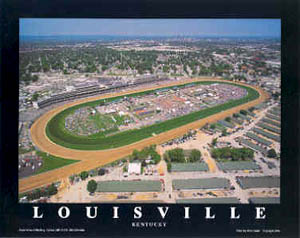Archives for March 2010
The Uniforms
 Silks (or colors) are the colorful jackets worn by a jockey during a race. The origin of the modern jockey silks comes from England.
Silks (or colors) are the colorful jackets worn by a jockey during a race. The origin of the modern jockey silks comes from England.
However, in ancient Rome, chariot drivers may have been the first to sport “racing colors.” They wore capes and headbands in bright colors to identify themselves. Although horse-racing meets are recorded as far back as 1114, individual silk colors are first mentioned in 1515 when Henry VIII occupied the throne. The costume itself was established in the latter part of the 17th and early 18th centuries. As the sport grew confusion resulted from the duplicity of entries which arose. It became absolutely necessary to vary color and design for positive identification. Both judges and spectators began to complain of the confusion. In 1762, the English Jockey Club requested that the owners submit specific colors for jacket and cap and to use them consistently in an attempt to distinguish riders among a field of horses or to settle disputes that might arise.
As racing has changed, so too have colors. Called silks because the early variations were, in fact, silk, today most are actually nylon or lycra. Aerodynamic silks have become more popular in recent years. While in their earliest iterations silks were merely different colors, today the designs can be quite intricate, ranging from geometric patterns to pictures and symbols. Approximately 28,000 sets of silks are registered with The Jockey Club today.
The Fans

 About the only feeling more invigorating than watching the horse you bet on to win come from behind to win by a nose would have to be that the horse is yours. The owner and the animal which you witness it’s birth, it’s growth as a yearling, it’s training and it’s arrival into it’s first winners circle is a partnership like no other. That, in horse racing, is the dream of most enthusiasts that ever plunked down a $2 win bet.
About the only feeling more invigorating than watching the horse you bet on to win come from behind to win by a nose would have to be that the horse is yours. The owner and the animal which you witness it’s birth, it’s growth as a yearling, it’s training and it’s arrival into it’s first winners circle is a partnership like no other. That, in horse racing, is the dream of most enthusiasts that ever plunked down a $2 win bet. Churchill Downs, pictured here, is one of the most famous race tracks in the United States. The mile race course opened in 1875 but is not the oldest. That honor goes to Saratoga Race Course in Saratoga Springs , NY which was established in 1863. Horse racing has been around longer than basketball and football and at one time in the 50’s & 60’s it’s annual total attendance was greater than all sports, even baseball.
Churchill Downs, pictured here, is one of the most famous race tracks in the United States. The mile race course opened in 1875 but is not the oldest. That honor goes to Saratoga Race Course in Saratoga Springs , NY which was established in 1863. Horse racing has been around longer than basketball and football and at one time in the 50’s & 60’s it’s annual total attendance was greater than all sports, even baseball. Here are three of the top trainers of our time, Nick Zito, D. Wayne Lukas and Bob Baffert. Trainers are the equivalent to coaches in other sports. They train the horse to react to different situations in a race as well as teaching the horse to pace itself throughout the race and when to kick it into high gear for the finish. Each horse has it’s own personality in which the trainers learn.
Here are three of the top trainers of our time, Nick Zito, D. Wayne Lukas and Bob Baffert. Trainers are the equivalent to coaches in other sports. They train the horse to react to different situations in a race as well as teaching the horse to pace itself throughout the race and when to kick it into high gear for the finish. Each horse has it’s own personality in which the trainers learn. Jockeys are a vital part of the sport of racing. They set the pace of the race and help the horse out maneuver and out smart the other horses. They are the brains of the brawn. However, they cannot make a horse run when it can’t or just won’t(I’ve bet on a few of those that just weren’t in the mood to run). The job is extremely dangerous but very exciting and rewarding. When figuring the outcome of a race, the combination of jockey/trainer is of utmost importance. Good trainers beget good horses and good horses beget good jockeys and good jockeys beget a winning performance. Pictured here is my father’s hero, Pat Day.
Jockeys are a vital part of the sport of racing. They set the pace of the race and help the horse out maneuver and out smart the other horses. They are the brains of the brawn. However, they cannot make a horse run when it can’t or just won’t(I’ve bet on a few of those that just weren’t in the mood to run). The job is extremely dangerous but very exciting and rewarding. When figuring the outcome of a race, the combination of jockey/trainer is of utmost importance. Good trainers beget good horses and good horses beget good jockeys and good jockeys beget a winning performance. Pictured here is my father’s hero, Pat Day.